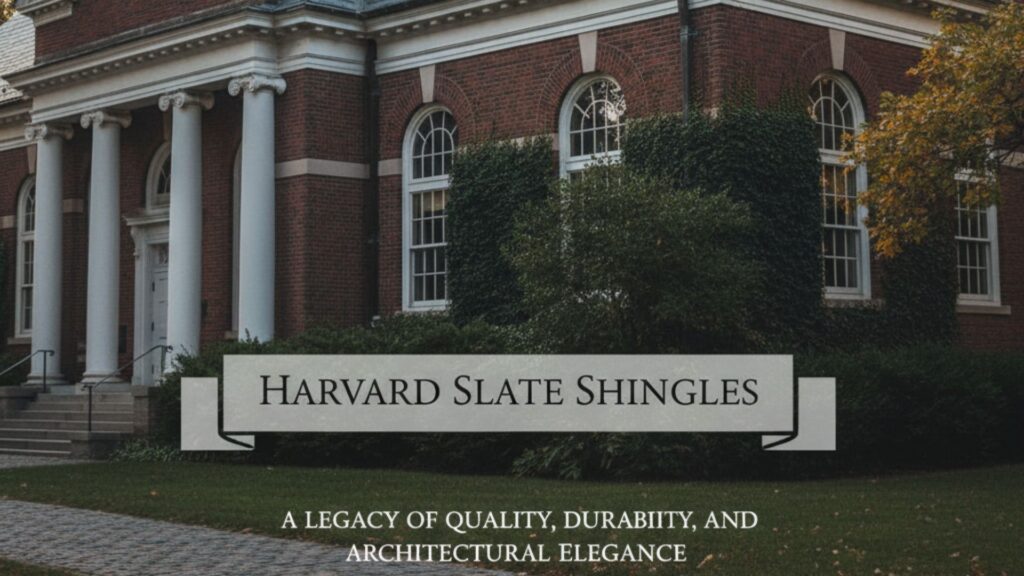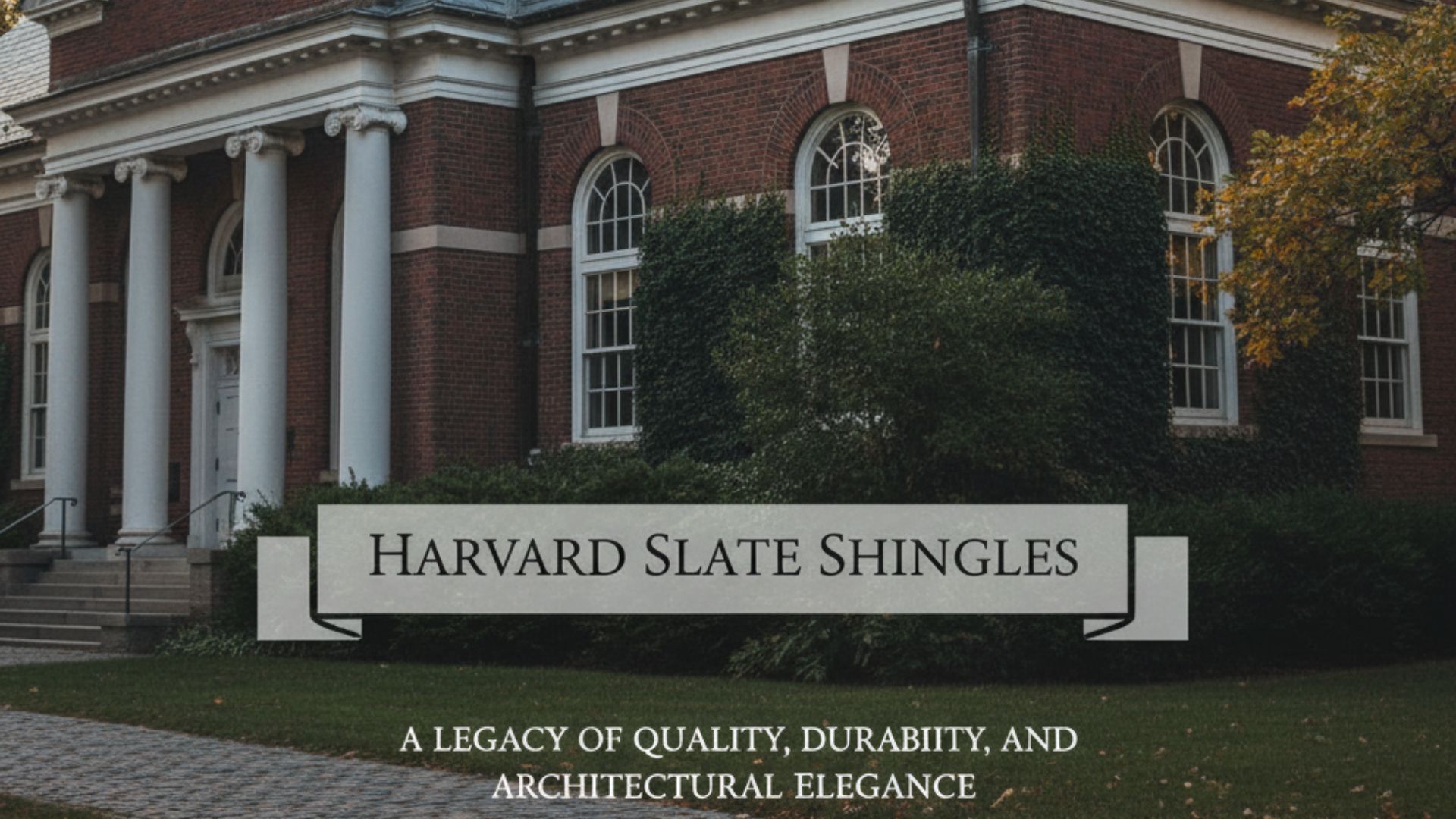Harvard Slate Shingles: Harvard Slate Shingles have become a hallmark of excellence in roofing materials, symbolizing not only quality but also timeless beauty and resilience. Known for their natural charm and long-lasting performance, these shingles have been used in various architectural designs across residential, commercial, and institutional buildings. Whether you are an architect, builder, or homeowner, understanding what makes Harvard Slate Shingles unique can help you make an informed decision when choosing roofing materials that blend aesthetics, durability, and value.

In this article, we will explore everything about Harvard Slate Shingles — their origin, features, types, installation methods, maintenance, benefits, and how they compare with other roofing options. Additionally, we will look at their environmental advantages and role in modern architecture while offering practical insights for those considering them for roofing projects.
Understanding Harvard Slate Shingles
Harvard Slate Shingles are high-quality roofing materials designed to resemble the natural beauty of quarried slate while offering the versatility of modern production. Slate has been used for centuries as a durable and elegant roofing material, and Harvard Slate brings this tradition into the contemporary construction world by enhancing functionality and reducing maintenance costs.
These shingles are typically made from natural stone (in traditional varieties) or advanced composite materials (in engineered forms) that replicate the visual appeal of authentic slate. The Harvard name in slate roofing is often associated with classic architectural projects, historical restorations, and modern premium homes that value sophistication and reliability.
Key Characteristics of Harvard Slate Shingles
- Durability:
Harvard Slate Shingles are designed to withstand harsh weather conditions, including rain, snow, wind, and sunlight exposure. Their long life span, often exceeding 75 years, makes them a one-time investment. - Aesthetic Appeal:
These shingles are admired for their natural appearance and deep, rich colors. Each piece carries unique textures that create an elegant, layered look on roofs. - Fire and Weather Resistance:
Slate shingles are non-combustible and highly resistant to temperature changes, making them ideal for areas prone to extreme weather. - Low Maintenance:
Once installed, they require minimal maintenance compared to asphalt or wooden shingles, as they do not warp or rot over time. - Sustainability:
Slate is a natural material that can be recycled or repurposed, reducing its environmental footprint. Synthetic versions of Harvard Slate are also eco-friendly, often made from recycled materials. - Cost Efficiency Over Time:
Though the initial installation cost is higher, their longevity and low maintenance make them more economical in the long run.
Composition and Manufacturing Process
Harvard Slate Shingles can be produced from natural slate stone or synthetic composites:
- Natural Slate:
Quarried from metamorphic rock, cut, and shaped into uniform tiles. Each tile is unique due to the natural variations in stone. - Synthetic Slate:
Made from engineered polymers and recycled rubber to mimic the appearance of real slate. These are lighter and easier to install while maintaining the same aesthetic charm.
The manufacturing process involves careful crafting, shaping, and color finishing to ensure that each shingle retains the signature “Harvard” look — refined, elegant, and enduring.
Types of Harvard Slate Shingles
- Standard Slate:
Uniform size and thickness, offering a clean and symmetrical roof pattern suitable for contemporary designs. - Textural Slate:
Varying thickness and texture for a rustic, natural appearance, ideal for heritage or country-style buildings. - Graduated Slate:
Larger, thicker tiles at the eaves that taper upward with smaller ones — often used in historic restoration or academic architecture. - Synthetic Slate:
A lightweight alternative that captures the natural charm of real slate while providing cost savings and simplified installation.
Applications of Harvard Slate Shingles
Harvard Slate Shingles are widely used in diverse architectural projects, including:
- Residential homes with luxury designs
- University buildings and libraries
- Churches, museums, and heritage restorations
- Commercial offices with classical facades
- Government and institutional structures
Their aesthetic versatility allows them to complement both traditional and modern architecture effortlessly.
Installation Process
Installing Harvard Slate Shingles requires skilled craftsmanship and precision. Below is a general outline of the process:
- Roof Deck Preparation:
The roof deck must be properly leveled, reinforced, and covered with underlayment to ensure moisture protection. - Layout Planning:
The shingles are arranged from the bottom up, with appropriate overlap to prevent water infiltration. - Fastening:
Copper or stainless-steel nails are used to secure each shingle, ensuring long-term stability and corrosion resistance. - Trimming and Finishing:
Ridge caps and edge tiles are fitted last to complete the installation with aesthetic precision.
Because of the complexity and precision required, professional installation is highly recommended.
Maintenance and Longevity
One of the defining features of Harvard Slate Shingles is their longevity. A properly installed slate roof can last for 75 to 100 years. Maintenance is relatively simple but essential:
- Regular inspections for cracked or slipped shingles
- Cleaning gutters and removing debris
- Replacing damaged tiles promptly
- Avoiding pressure washing or chemical cleaners
Periodic professional assessments can help ensure that the roof remains in top condition for decades.
Advantages of Choosing Harvard Slate Shingles
| Feature | Advantage |
|---|---|
| Aesthetics | Enhances property value with a classic, sophisticated appearance |
| Durability | Can last over 75 years with minimal maintenance |
| Eco-Friendly | Natural or recycled materials reduce environmental impact |
| Fire Resistance | Provides superior safety against fire hazards |
| Weather Resistance | Performs well in all climates |
| Low Maintenance | Requires little upkeep compared to other materials |
Cost of Harvard Slate Shingles
While the cost varies depending on material type and location, here is an approximate breakdown:
- Natural Slate Shingles: $10–$20 per square foot (installation included)
- Synthetic Slate Shingles: $7–$12 per square foot
Although the initial investment is higher, the longevity and durability justify the expense, making it a wise long-term decision for property owners.
Environmental Benefits
Slate roofing is one of the most sustainable options available today. Natural slate is extracted with minimal processing, and synthetic versions often use recycled components. Additionally, the long life span of Harvard Slate Shingles means fewer replacements and reduced landfill waste. Their reflective surface also contributes to better thermal efficiency, potentially lowering energy consumption.
Harvard Slate in Architectural History
Slate roofing has a deep connection with historical architecture, including iconic universities like Harvard. Many academic and heritage buildings feature slate shingles for their timeless appeal and symbolic prestige. Today, Harvard Slate Shingles continue to carry that legacy, often used in projects seeking a balance between tradition and innovation.
Important Links and Information
| Category | Details / Links |
|---|---|
| Official Product Website | Harvard Slate Roofing Information |
| Material Types | Natural Slate, Synthetic Slate |
| Installation Guide | Available through certified roofing contractors |
| Maintenance Tips | Annual inspection and debris removal |
| Warranty Information | Depends on manufacturer (typically 50+ years) |
| Environmental Certification | Many synthetic varieties are LEED certified |
| Contact for Suppliers | Check local roofing material distributors |
FAQ about Harvard Slate Shingles
What makes Harvard Slate Shingles different from regular slate?
Harvard Slate Shingles are known for their superior craftsmanship, consistent quality, and long-lasting performance. They maintain the authentic look of traditional slate while incorporating modern durability standards.
How long does a Harvard Slate roof last?
With proper installation and minimal maintenance, a Harvard Slate roof can last between 75 and 100 years, far exceeding most other roofing materials.
Are synthetic Harvard Slate Shingles as durable as natural ones?
Yes, synthetic versions are engineered to replicate the strength, appearance, and weather resistance of natural slate while being lighter and more affordable.
Can I install Harvard Slate Shingles myself?
It is recommended to hire professional installers due to the precision and expertise required for proper installation.
Do Harvard Slate Shingles add value to a property?
Absolutely. Their visual appeal and longevity significantly increase property value and curb appeal.
Are Harvard Slate Shingles environmentally friendly?
Yes, both natural and synthetic varieties are eco-friendly options due to their recyclable nature and long lifespan.
What colors are available in Harvard Slate Shingles?
They come in various shades, including gray, black, green, purple, and multicolor blends that mimic natural stone variations.
How do Harvard Slate Shingles perform in cold climates?
They are highly resistant to freeze-thaw cycles, making them ideal for colder regions.
Are there warranties available?
Yes, many manufacturers provide warranties ranging from 50 years to lifetime coverage, depending on the product type.
Can Harvard Slate Shingles be used for historical restorations?
Yes, they are often chosen for restoration projects to maintain historical authenticity while improving durability.
Conclusion
Harvard Slate Shingles represent a perfect fusion of heritage, craftsmanship, and innovation. They are more than just roofing materials — they are architectural statements that reflect durability, beauty, and environmental responsibility. Whether used in residential homes, educational institutions, or historical restorations, these shingles continue to define standards of excellence in roofing design.
For homeowners and architects seeking a timeless and sustainable roofing solution, Harvard Slate Shingles remain one of the most reliable and aesthetically pleasing options available today. Their combination of elegance, performance, and longevity ensures that they not only protect buildings but also enhance their character for generations to come.

